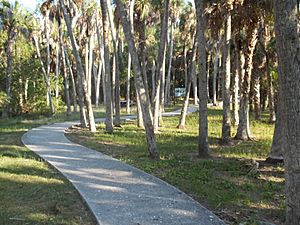Madira Bickel Mound State Archaeological Site facts for kids
Quick facts for kids Madira Bickel Mound State Archaeological Site |
|
|---|---|
|
IUCN Category V (Protected Landscape/Seascape)
|
|
| Location | Manatee County, Florida, USA |
| Nearest city | Palmetto, Florida |
| Area | 10 acres (0.040 km2) |
| Established | August 12, 1970 |
| Governing body | Florida Department of Environmental Protection |
The Madira Bickel Mound State Archaeological Site is a special place on Terra Ceia Island in Florida. It's where scientists study old things to learn about people who lived long ago. This site is near Palmetto, Florida, and you can find it on Bayshore Drive.
This 10-acre (0.040 km2) site was the first place in Florida where Native American history was protected as a State Archaeological Site. It was added to the National Register of Historic Places in 1970. It is also a Florida State Park, which means it's a public park managed by the state.
A Look Back in Time
Scientists have dug here and found proof that people lived on this land for about 2,000 years! Different groups of people lived here over time. These groups are known as the Manasota, Weedon Island, and Safety Harbor cultures.
These ancient people built a huge mound out of shells, sand, and other natural materials. This mound was used for important ceremonies or as a temple. It is still 20-foot (6.1 m) tall today. Its base is about 100 feet (30 m) wide and 170 feet (52 m) long.
Experts believe this mound stayed important for many years. Later, the Tocobaga people used it. The Tocobaga were a Native American tribe who lived in this area before Europeans arrived. They lived here until the 1700s. Sadly, many of them died from new diseases and wars.
The site is named after Madira Bickel. She lived in Sarasota. In 1948, she and her husband, Karl, bought the land around the main mound. They then gave it to the state of Florida so it could be protected.
Exploring the Mounds
The most interesting part of the site is the big 20-foot (6.1 m) tall mound. It's made of shells, sand, and other natural bits. The shells came from a large pile of ancient trash, called a midden, nearby. The mound's base is about 100 feet (30 m) by 170 feet (52 m).
To make it easier to get to the top, the Tocobaga people built a curved ramp. This ramp was about 10-foot (3.0 m) wide and was on the west side of the mound.
Today, the state park has stairs that you can use to climb to the top. There's a fenced area at the top where you can look out over the park. Over hundreds of years, the mound has become covered with plants and tall trees.
The park also has the remains of another mound called the Prine Burial Mound. This mound is round, about 40 feet (12 m) wide, and about 2 feet (0.61 m) tall in the middle. It was used by all three ancient cultures mentioned earlier, from about 800 AD to 1500 AD. Over time, people moving into the area disturbed much of this smaller mound.



